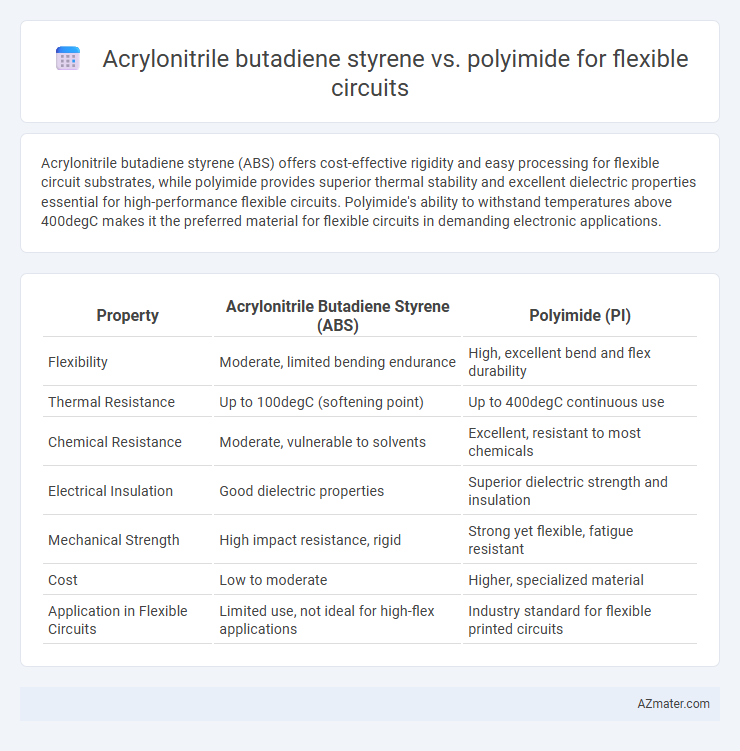Acrylonitrile butadiene styrene (ABS) offers cost-effective rigidity and easy processing for flexible circuit substrates, while polyimide provides superior thermal stability and excellent dielectric properties essential for high-performance flexible circuits. Polyimide's ability to withstand temperatures above 400degC makes it the preferred material for flexible circuits in demanding electronic applications.
Table of Comparison
| Property | Acrylonitrile Butadiene Styrene (ABS) | Polyimide (PI) |
|---|---|---|
| Flexibility | Moderate, limited bending endurance | High, excellent bend and flex durability |
| Thermal Resistance | Up to 100degC (softening point) | Up to 400degC continuous use |
| Chemical Resistance | Moderate, vulnerable to solvents | Excellent, resistant to most chemicals |
| Electrical Insulation | Good dielectric properties | Superior dielectric strength and insulation |
| Mechanical Strength | High impact resistance, rigid | Strong yet flexible, fatigue resistant |
| Cost | Low to moderate | Higher, specialized material |
| Application in Flexible Circuits | Limited use, not ideal for high-flex applications | Industry standard for flexible printed circuits |
Introduction to Flexible Circuit Materials
Acrylonitrile butadiene styrene (ABS) offers affordability and good mechanical strength, making it suitable for flexible circuit substrates in applications requiring moderate flexibility and durability. Polyimide, known for its exceptional thermal stability, chemical resistance, and excellent flexibility, is preferred for high-performance flexible circuits operating in harsh environments or at elevated temperatures. The choice between ABS and polyimide depends on specific application requirements such as mechanical stress, thermal conditions, and budget constraints.
Overview of Acrylonitrile Butadiene Styrene (ABS)
Acrylonitrile Butadiene Styrene (ABS) is a thermoplastic polymer known for its toughness, impact resistance, and ease of fabrication, making it a common choice in flexible circuit applications where mechanical durability is required. ABS exhibits good electrical insulation properties, moderate heat resistance up to approximately 100degC, and cost-effectiveness compared to high-performance polymers like polyimide. While ABS provides versatility and robustness, its thermal stability and flexibility are inferior to polyimide, limiting its use in high-temperature or highly flexible electronic circuit designs.
Key Properties of Polyimide
Polyimide offers superior thermal stability withstanding temperatures up to 400degC, making it ideal for high-temperature flexible circuits compared to Acrylonitrile Butadiene Styrene (ABS), which has a lower melting point around 200degC. Its excellent chemical resistance and mechanical flexibility ensure durability and consistent electrical performance under bending and flexing stresses. High dielectric strength and low moisture absorption further enhance polyimide's suitability for reliable, long-lasting flexible electronic applications.
Mechanical Flexibility: ABS vs. Polyimide
Polyimide exhibits superior mechanical flexibility compared to Acrylonitrile Butadiene Styrene (ABS), making it ideal for flexible circuit applications requiring repeated bending and dynamic motion. ABS, while durable and impact-resistant, lacks the high-temperature tolerance and elongation properties necessary for advanced flex circuits. Polyimide's excellent tensile strength and thermal stability enable it to maintain electrical integrity under mechanical stress, outperforming ABS in demanding flexible electronics environments.
Thermal Resistance Comparison
Acrylonitrile butadiene styrene (ABS) exhibits a thermal resistance typically up to 100degC, limiting its application in high-temperature flexible circuits. Polyimide, on the other hand, withstands temperatures exceeding 400degC, making it ideal for advanced flexible circuit substrates exposed to extreme thermal environments. The superior thermal stability of polyimide ensures reliable performance and longevity in flexible electronics subjected to continuous heat stress.
Chemical Stability and Durability
Acrylonitrile butadiene styrene (ABS) exhibits moderate chemical stability with resistance to acids and alkalis but may degrade under prolonged exposure to solvents and UV light, impacting its durability in flexible circuits. Polyimide demonstrates superior chemical resistance, maintaining integrity against harsh chemicals, solvents, and extreme temperatures, which enhances its long-term durability in flexible circuit applications. The inherent thermal stability and chemical inertness of polyimide make it the preferred material for flexible circuits requiring high performance in chemically aggressive environments.
Electrical Performance in Flexible Circuits
Acrylonitrile butadiene styrene (ABS) exhibits moderate dielectric constant and dissipation factor, making it suitable for standard flexible circuit applications with stable electrical insulation properties. Polyimide offers superior electrical performance characterized by low dielectric constant (typically around 3.4) and excellent thermal stability, which supports minimal signal loss and high-frequency signal integrity in flexible circuits. For advanced flexible electronics requiring high-speed signal transmission and harsh environment resistance, polyimide outperforms ABS by maintaining consistent electrical characteristics under thermal and mechanical stress.
Cost Considerations and Availability
Acrylonitrile butadiene styrene (ABS) offers lower material costs and widespread availability, making it the preferred choice for budget-sensitive flexible circuit applications. Polyimide, though significantly more expensive, provides superior thermal stability and chemical resistance, justifying its cost in high-performance or harsh environment circuits. Manufacturing lead times and supplier diversity favor ABS, whereas polyimide's specialized production processes can result in limited availability and longer procurement cycles.
Applications and Industry Preferences
Acrylonitrile butadiene styrene (ABS) is widely used in flexible circuits for consumer electronics and automotive applications due to its impact resistance and cost-effectiveness, while polyimide is preferred in aerospace and medical industries for its superior thermal stability and chemical resistance. Polyimide's ability to maintain performance under extreme temperatures makes it ideal for high-reliability flexible circuits in military and industrial sectors. Industry preferences favor ABS for prototyping and cost-sensitive products, but polyimide dominates high-performance applications requiring durability and longevity.
Conclusion: Choosing the Right Material for Flexible Circuits
Acrylonitrile butadiene styrene (ABS) offers cost-effective, rigid support with moderate thermal resistance, making it suitable for flexible circuits requiring durability at lower operating temperatures. Polyimide excels with superior thermal stability, chemical resistance, and mechanical flexibility, which is critical for high-performance flexible circuits in demanding environments. Selecting the appropriate material depends on specific application requirements such as operating temperature, flexibility needs, and environmental exposure to ensure optimal circuit performance and longevity.

Infographic: Acrylonitrile butadiene styrene vs Polyimide for Flexible circuit
 azmater.com
azmater.com